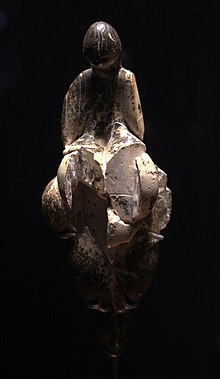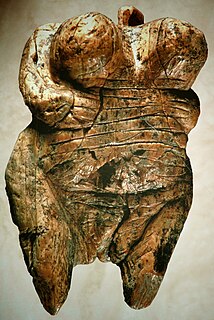
The Venus of Willendorf is an 11.1-centimetre-tall (4.4 in) Venus figurine estimated to have been made 30,000 BCE. It was found on August 7, 1908 by a workman named Johann Veran or Josef Veram during excavations conducted by archaeologists Josef Szombathy, Hugo Obermaier and Josef Bayer at a paleolithic site near Willendorf, a village in Lower Austria near the town of Krems. It is carved from an oolitic limestone that is not local to the area, and tinted with red ochre. The figurine is now in the Naturhistorisches Museum in Vienna, Austria.
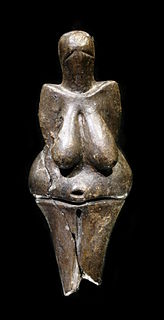
The Venus of Dolní Věstonice is a Venus figurine, a ceramic statuette of a nude female figure dated to 29,000–25,000 BCE, or 29,000 - 25,000 BC. It was found at the Paleolithic site Dolní Věstonice in the Moravian basin south of Brno, in the base of Děvín Mountain, 549 metres (1,801 ft). This figurine and a few others from locations nearby are the oldest known ceramic articles in the world.

The Venus of Laussel is an 18.11-inch-high (46.0-centimetre) limestone bas-relief of a nude woman. It is painted with red ochre and was carved into the limestone of a rock shelter in the commune of Marquay, in the Dordogne department of south-western France. The carving is associated with the Gravettian Upper Paleolithic culture. It is currently displayed in the Musée d'Aquitaine in Bordeaux, France.
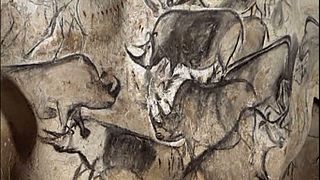
The Aurignacian is an archaeological tradition of the Upper Palaeolithic associated with European early modern humans (EEMH). The Upper Paleolithic developed in Europe some time after the Levant, where the Emiran period and the Ahmarian period form the very first periods of the Upper Paleolithic, corresponding to the first stages of the expansion of Homo sapiens out of Africa. From this stage, the first modern humans probably migrated to Europe to form the beginning of the European Upper Paleolithic, including the Aurignacian culture.

The Venus of Brassempouy is a fragmentary ivory figurine from the Upper Palaeolithic. It was discovered in a cave at Brassempouy, France in 1892. About 25,000 years old, it is one of the earliest known realistic representations of a human face.

The Löwenmensch figurine or Lion-man of the Hohlenstein-Stadel is a prehistoric ivory sculpture discovered in the Hohlenstein-Stadel, a German cave in 1939. The German name, Löwenmensch, meaning "lion-human", is used most frequently because it was discovered and is exhibited in Germany.
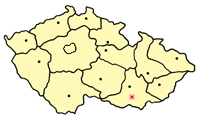
Dolní Věstonice refers to an Upper Paleolithic archaeological site near the village of Dolní Věstonice, Moravia in the Czech Republic,on the base of Děvín Mountain 549 metres (1,801 ft), dating to approximately 26,000 BP, as supported by radiocarbon dating. The site is unique in that it has been a particularly abundant source of prehistoric artifacts dating from the Gravettian period, which spanned roughly 27,000 to 20,000 B.C. In addition to the abundance of art, this site also includes carved representations of men, women, and animals, along with personal ornaments, human burials and enigmatic engravings.

Paleolithic religions are a set of spiritual beliefs thought to have appeared during the Paleolithic time period. Paleoanthropologists Andre Leroi-Gourhan and Annette Michelson believe Religious behaviour emerged by the Upper Paleolithic, before 30,000 years ago at the latest, but behavioral patterns such as burial rites that one might characterize as religious — or as ancestral to religious behaviour — reach back into the Middle Paleolithic, as early as 300,000 years ago, coinciding with the first appearance of Homo neanderthalensis and possibly Homo naledi.

The Venus of Hohle Fels is an Upper Paleolithic Venus figurine made of mammoth ivory that was unearthed in 2008 in Hohle Fels, a cave near Schelklingen, Germany. It is dated to between 40,000 and 35,000 years ago, belonging to the early Aurignacian, at the very beginning of the Upper Paleolithic, which is associated with the earliest presence of Cro-Magnon in Europe.
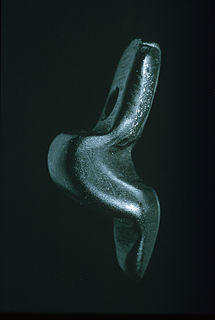
The Venus of Monruz is a Venus figurine of the late Upper Paleolithic, or the beginning Epipaleolithic, dating to the end of the Magdalenian, some 11,000 years ago. It is a black jet pendant in the shape of a stylized human body, measuring 18 mm in height. It was discovered in 1991, at the construction of the N5 highway, at Monruz in the municipality of Neuchâtel, Switzerland.

The Mal'ta–Buret' culture is an archaeological culture of the Upper Paleolithic on the upper Angara River in the area west of Lake Baikal in the Irkutsk Oblast, Siberia, Russian Federation. The type sites are named for the villages of Mal'ta (Мальта́), Usolsky District and Buret' (Буреть), Bokhansky District.

The Venus of Moravany is a small prehistoric female figurine discovered in Slovakia in the early 20th century.
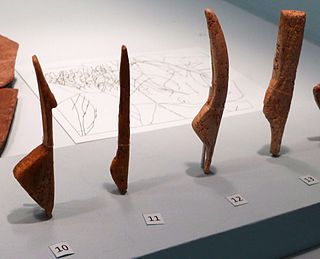
The Venus figurines from Gönnersdorf, at Neuwied, are paleolithic sculptures depicting the female body.
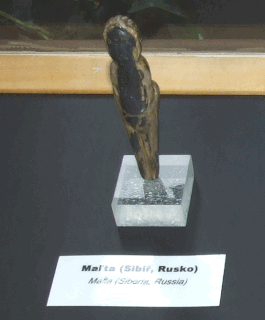
The Venus figurines of Mal’ta are several palaeolithic figurines of women found in Siberia, Russia.
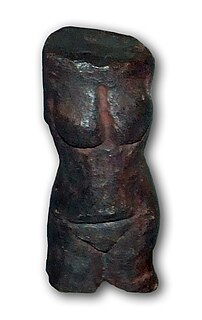
The Venus of Petřkovice is a pre-historic Venus figurine, a mineral statuette of a nude female figure, dated to about 23,000 BCE in what is today the Czech Republic.
Venus of Buret' may refer to any of the five Venus figurines found from archeological site of Buret' in Siberia near Irkutsk and the Angara river valley.

The Venus figurines of Gagarino are eight Palaeolithic Venus figurines made from ivory. The statuettes belong to the Gravettian industry and are about 21,000–20,000 years old. They were discovered near to the village of Gagarino in Lipetsk Oblast, Russia, and are now held in the Hermitage Museum in Saint Petersburg.

The Venus figurines of Balzi Rossi from the caves near Grimaldi di Ventimiglia (Italy) are thirteen Paleolithic sculptures of the female body. Additionally, two small depictions of the human head were discovered at the same place. The age of these figurines cannot be determined because of missing archaeological context data. It is usually accepted that these figurines stem from the Gravettian, about 24,000 to 19,000 years old. Most of the sculptures consist of steatite and are between 2.4 and 7.5 cm in height. Between 1883 to 1895 the figurines were discovered by the antique dealer Louis Alexandre Jullien at the cave complex Balzi Rossi at the Ligurian coast. Eight of these sculptures are housed in the museum Saint-Germain-en-Laye near Paris.
